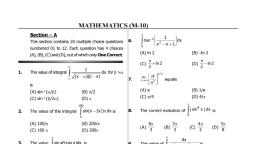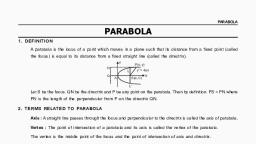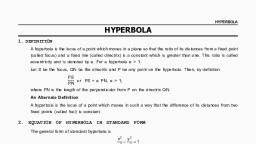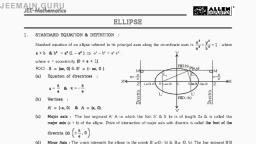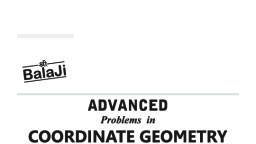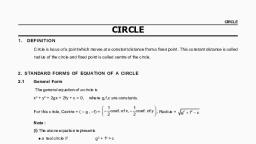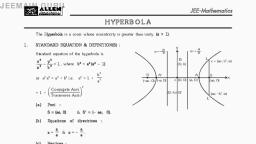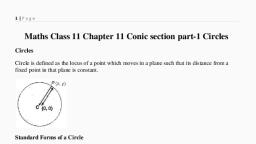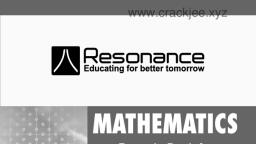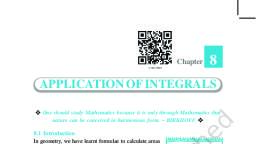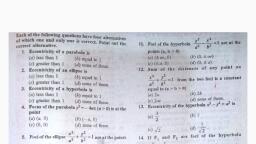Page 1 :
ELLIPSE, , ELLIPSE, 1. DEFINITION, An ellipse is the locus of a point which moves in a plane so that the ratio, of its distance from a fixed point (called focus) and a fixed line (called directrix), is a constant which is less than one. This ratio is called eccentricity and, , Let S be the focus, QN be the directrix and P be any point on the ellipse., , Directrix, , is denoted by e. For an ellipse, e < 1., , P(x, y), , N, , S(focus), Q, , PS, = e or, Then, by definition,, PN, , PS = e PN, e < 1, where PN is the length of the perpendicular from P on the directrix QN., An Alternate Definition An ellipse is the locus of a point that moves in such a way that the sum of its distacnes, from two fixed points (called foci) is constant., , 2. EQUATION OF AN ELLIPSE IN STANDARD FORM, The Standard form of the equation of an ellipse is, x2, a2, , , , y2, b2, , 1 (a b ) ,, , where a and b are constants., , Directrix, , A'(-a,0), , S', N', , Minor, , X', , M, , L, , Major Axis, C, , N, , S, , X, , A(a,0), , Z, , L', , P', B(0, -b), , N, Z', , Axis, , P(x, y), , Directrix, , x=-a/e, , M', , x = a/e, , B(0, b), , Y, , 3. TERMS RELATED TO AN ELLIPSE, , x2 y2, A sketch of the locus of a moving point satisfying the equation 2 2 1 (a b) , has been shown in the, a, b, figure given above., , Symmetry, (a) On replacing y by –y, the above equation remains unchanged. So, the curve is symmetrical about x-axis., (b) On replacing x by –x, the above equation remains unchanged. So, the curve is symmetrical about y-axis, 117
Page 2 :
ELLIPSE, , Foci, If S and S' are the two foci of the ellipse and their coordinates are (ae, 0) and (–ae, 0) respectively, then distance, between foci is given by, SS' = 2ae., Directrices, If ZM and Z' M' are the two directrices of the ellipse and their equations are x =, , a, a, and x = –, respectively,,, e, e, , then the distance between directrices is given by, 2a, ., e, , ZZ' =, Axes, , The lines AA' and BB' are called the major axis and minor axis respectively of the ellipse., The length of major axis = AA' = 2a, The length of minor axis = BB' = 2b, Centre, The point of intersection C of the axes of the ellipse is called the centre of the ellipse. All chords, passing, through C are bisected at C., Vertices, The end points A and A' of the major axis are known as the vertices of the ellipse, A (a, 0) and A' (–a, 0), Focal chord, A chord of the ellipse passing through its focus is called a focal chord., Ordinate and Double Ordinate, Let P be a point on the ellipse. From P, draw PN AA' (major axis of the ellipse) and produce PN to meet, the ellipse at P'. Then PN is called an ordinate and PNP' is called the double ordinate of the point P., Latus Rectum, If LL' and NN' are the latus rectum of the ellipse, then these lines are to the major axis AA' passing through, the foci S and S' respectively., , , b2, L ae,, , a, , , , ,, , , , , b 2 , L' ae,, , a , , , , b 2 , N ae,, , a ,, , Length of latus rectum = LL' =, , , b 2 , N' ae,, , a , , , 2b 2, NN' ., a, , , a, By definition SP = ePM = e x = a – ex and, , e, , , a, S' P e x a ex., , e, 118
Page 3 :
ELLIPSE, , Thus implies that distances of any point P(x, y) lying on the ellipse from foci are : (a – ex) and (a + ex). In, other words, SP + S'P = 2a, i.e., sum of distances of any point P(x, y) lying on the ellipse from foci is constant., Eccentricity, Since, SP = ePM, therefore, SP2 = e2 PM2, or, , a, , (x – ae) + (y – 0) = e x , e, , , 2, , 2, , 2, , 2, , (x – ae)2 + y2 = (a – ex)2, x2 + a2e2 – 2aex + y2 = a2 – 2aex + e2x 2, x2 (1 – e2) + y2 = a2 (1 – e2), , x2, a2, On comparing with, , , , y2, a 2 (1 e 2 ), , 1., , x2 y2, , 1, we get, a2 b2, 2, , 2, , 2, , b = a (1 – e ), , 1, , or e =, , b2, a2, , Auxillary Circle, The circle drawn on major axis AA' as diameter is known as the Auciliary circle., Q, P, , C, , A', , Let the equation of the ellipse be, , x2, a, , 2, , , , y2, b2, , M, , A, , X, , 1. Then the equation of its auxiliary circle is, , x 2 + y2 = a 2 ., Let Q be a point on auxiliary circle so that QM, perpendicular to major axis meets the ellipse at P. The points, P and Q are called as corresponding point on the ellipse and auxiliary circle respectively., The angle is known as eccentric angle of the point P on the ellipse., It may be noted that the CQ and not CP is inclined at with x-axis., 119
Page 4 :
ELLIPSE, , 4. TWO STANDARD FORMS OF THE ELLIPSE, , Standard equation, , x2, a2, , , , y2, , x 2 y2, , 1 (a b), b 2 a2, , 1 (a b ), , b2, , (Horizontal Form of an Ellipse), , (Vertical Form of an ellipse), Y, y=a/e, , A(0, a), B(0, b), , Y, M, , S(0, ae), , L', , L, , x=-a/e, , B(0,-b), , M', , L', , X, , Y, B'(-b, 0), , (0,-ae), , (ae, 0), S, , O, , A(a, 0), , (-ae, 0), S', , A(-a, 0), , Shape of the ellipse, , L, , M, , x= a/e, , O, S', , B(b, 0), , X, , M, , A'(0,-a), , y=-a/e, , Centre, , (0, 0), , (0, 0), , Equation of major axis, , y = 0, , x = 0, , Equation of minor axis, , x = 0, , y = 0, , Length of major axis, , 2a, , 2a, , Length of minor axis, , 2b, , 2b, , Foci, , (± ae, 0), , (0, ± ae), , Vertices, , (± a, 0), , (0, ± a), , Equation of directrices, , x, , Eccentricity, , e, , Length of latus rectum, , 2b 2, a, , Ends of latus rectum, , 2, , ae, b, , a, , , Parametric coordinates, , (a cos , b sin ), , (a cos , b sin ), , Focal radius, , P = a – ex1 and S'P = a + ex1, , SP = a – ey1 and S'P = a + ey1., , Sum of focal radii SP+S'P=, , 2a, , 2a, , Distance between foci, , 2ae, , 2ae, , Distance b/w directrices, , 2a, e, , 2a, e, , Tangents at the vertices, , x = ± a, , y = ± a, , a, e, , y, , a2 b2, a, , 2, , e, , a, e, , a2 b2, a2, , 2b 2, a, , , , , , , b2, , , , ae , a, , , , , 120
Page 5 :
ELLIPSE, , Ex.1, , Find the centre, the length of the axes, eccentricity and the foci of the ellipse., 12x2 + 4y2 + 24x – 16y + 25 = 0, , Sol., , The given equation can be written in the form, 12(x + 1)2 + 4(y – 2)2 = 3, , ( x 1)2 ( y 2)2, , 1, 1/ 4, 3/4, , or, , ....(1), , Co-ordinates of centre of the ellipse are given by, x + 1 = 0 and y – 2 = 0, hence centre of the ellipse is (–1, 2), If a and b be the lengths of the semi major and semi minor axes, then a2 = 3/4, b2 = 1/4, Length of major axis = 2a =, , 3,, a=, , Length of minor axis = 2b = 1, Since b2 = a2 (1 – e2), , 1, 3, ,b=, 2, 2, , 1/4 = 3/4 (1 – e2) e =, , ae =, , 2/3, , 3, 2, 1, , , ,, 2, 3, 2, , Co-ordinates of foci are given by x + 1 = 0, y – 2 = ± ae, , , 1 , , Thus foci are 1, 2 , 2, , Ex.2, , Find the equation of the ellipse having its centre at the point (2, –3) one focus at (3, –3) and one vertex at (4, –3)., , Sol., , C (2, –3), S (3, –3) and A (4, –3), Now CA =, , a=2, , ( 4 2)2 ( 3 3)2 2, , Again CA =, , ae = 1, , (3 2 ) 2 ( 3 3 ) 2 1, , Let the directrix cut the major-axis at Q. Then, , e=, , 1 1, , a 2, , 1, AS, e, 2, AQ, , If Q (, ), then SA : AQ = e : 1 = 1 : 2, 6 6, ,, ( 4, 3), A , 3 , 3, , , , , , 6, 6, 4,, 3, 3, 3, , = 6, = –3, , Slope of CA = 0, therefore directrix will be parallel to y-axis., Since directrix is parallel to y-axis and it passes through point Q(6, –3), equation of directrix will be x = 6, Let P(x, y) is a point on ellipse. then, , e, , 1 PS, , , 2 PN, , ( x 3) 2 ( y 3) 2, x 6 / 12, , 1 ( x 3)2 ( y 3) 2, , ;, , 4, ( x 6)2, , or (x – 6)2 = 4 [(x – 3)2 + (y + 3)2], , or x2 – 12x + 36 = 4 [x2 – 6x + 9 + y2 + 6y + 9], or 3x2 + 4y2 – 12x + 24y + 36 = 0, 121
Page 6 :
ELLIPSE, , 5. GENERAL EQUATION OF THE ELLIPSE, The general equation of an ellipse whose focus is (h, k) and the directrix is the line ax + by + c = 0 and the, eccentricity will be e. Then let P(x1, y1) be any point on the ellipse which moves such that, SP = CPM, , , (x1 – h)2 + (y1 – k)2 =, , e 2 (ax 1 by 1 c ) 2, a2 b2, , Hence the locus of (x1, y1) will be given by, (a2 + b2) [(x – h)2 + (y – k)2] = e2 (ax + by + c)2, Which is the equation of second degree from which we can say that any equation of second degree represent, equation of an ellipse., Note : Condition for second degree in X and Y to represent an ellipse is thay if h 2 = ab < 0 &, = abc + 2 fgh – af2 – by2 – ch2 0., , 6. PARAMETRIC EQUATION OF THE ELLIPSE, The coordinates x = a cos and y = b sin satisfy the equation, x2, a, , 2, , , , y2, b2, , 1, , for all real values of . Thus, x = a cos , y = b sin are the parametric equation of the ellipse, where the parameter 0 < 2., Hence the coordinates of any point on the ellipse, , x2, a2, , , , y2, b2, , x2, a2, , , , y2, b2, , 1,, , 1, , may be taken as (a cos , b sin ). This point is also called the point ''., The angle is called the eccentric angle of the point (a cos , b sin ) on the ellipse., Equation of Chord, The equation of the chord joining the points P (acos 1, bsin 1) and Q (acos 2, bsin 2) is, x, 2 y, 2 , 2 , cos 1, sin 1, cos 1, ., a, 2, b, 2, , , , , 2 , , 7. POSITION OF A POINT WITH RESPECT TO AN ELLIPSE, The point P(x1, y1) lies outside, on or inside the ellipse, x 12, a2, , , , y12, b2, , x2, a2, , , , y2, b2, , 1 according as, , 1 0, 0 or < 0., , 8. CONDITION OF TANGENCY AND POINT OF CONTACT, The condition for the line y = mx + c to be a tangent to the ellipse, the coordinates of the points of contact are, , a 2m, , ,, , 2 2, 2, a, m, , b, , Note, , x2, a2, , , , y2, b2, , 1 is that c2 = a2m2 + b2 and, , , , , a 2m 2 b 2 , b2, , x cos a + y sin a = p is a tangent if p2 = a2 cos2 + b2 sin2., lx + my + n = 0 is a tangent if n2 = a2l2 + b2m 2., 122
Page 7 :
ELLIPSE, , 9. EQUATION OF TANGENT IN DIFFERENT FORMS, (i) Point Form, x2, , The equation of the tangent to the ellipse, at the point (x1, y1) is, , xx1, a, , 2, , , , yy1, b2, , y2, , , , a2, , b2, , 1., , 1, , Note : The equation of tangent at (x1, y1) can also be obtained by replacing x2 by xx1, y2 by yy1.x by, , x x1, ,, 2, , y y1, xy1 x1y, , and xx by, . This method is used only when the equation of ellipse is a polynomial, 2, 2, of second degree in x and y., , y by, , (ii) Parametric Form, x2, , The equation of the tangent to the ellipse, , a2, , , , y2, b2, , 1 at the point (acos , bsin ) is, , x, y, cos +, sin = 1., a, b, , (iii) Slope Form, The equation of tangent to the ellipse, , x2, a2, , , , y2, b2, , 1 in terms of slope 'm' is, , y mx a 2m 2 b 2, The coordinates of the points of contact are, , a 2m, , ,, , a 2m 2 b 2, , , , , 2 2, 2 , a m b , b2, , Note :, Number of Tangent Drawn From a Point, Two tangents can be drawn from a point to an ellipse. The two tangents are real and distinct or coincident, or imaginary according as the given point lies outside, on or inside the ellipse., Director Circle, It is the locus of points from which perpendicular tangents are drawn to the ellipse. The equation of Director, Circle of the ellipse., x2, a2, , , , y2, b2, , 1 is x 2 + y2 = a2 + b2., , The product of perpendicualr from the foci on any tangent to the ellipse, , x2, a2, , , , Ex.3, , For what value of does the line y = x + touches the ellipse 9x2 + 16y2 = 144., , Sol., , Equation of ellipse is, , Comparing this with, , y2, b2, , 1 is equal to b2., , x2 y2, , 1, 9x2 + 16y2 = 144, or, 16 9, x2 y2, , 1 then we get a2 = 16 and b2 = 9, a2 b2, , and comparing the line y = x + with y = mx + c, , , , m = 1 and c = , , If the line y = x + touches the ellipse 9x2 + 16y2 = 144, then c2 = a2m2 + b2, , , 2 = 16 × 12 + 9, , , , 2 = 25, , , , =±5, 123
Page 9 :
ELLIPSE, , Notes :, , , The coordinates of the points of contact are, , , a2, mb 2, , , ,, , 2, 2 2, 2, 2 2 , a, , b, m, , a, b, m, , , Condition for normality The line = mx + c is normal to the ellipse, x2, a2, , , , y2, b2, , 2, 1 if c , , m 2 (a 2 b 2 ) 2, ( a 2 b 2m 2 ), , Number of Normals, In general, four normals can be drawn to an ellipse from a point in its plane i.e., there are four points, on the ellipse, the normals at which it will pass through a given point. These four points are called the, co-normal points., , , if , , , are the eccentric angles of the four points on the ellipse such that the normals at these, , , , points are concurrent, then ( + + + ) is an odd multiple of ., x2 y2, If , , are the eccentric angles of three points on the ellipse 2 2 1, the normals at which are, a, b, concurrent, then, sin ( + ) + sin ( + ) + sin ( + ) = 0., , Ex.6, , Find the condition that the line lx + my = n may be a normal to the ellipse, , Sol., , Equation of normal to the given ellipse at (a cos , b sin ) is, , sin =, , and, , y2, b2, , an, , cos , a, (a 2 b2 ), , or, , 1., , ....(3), , bn, , ...(4), , m(a 2 b 2 ), , Squaring and adding (3) and (4), we get 1 , , Sol., , a2, , , , ax, by, , a2 b2, ...(1), cos sin , If the line lx + my = n is also normal to the ellipse then there must be a value of for which line (1) and line lx +, my = n are identical. For that value of we have, , 1, m, n, , , a , b (a2 b2 ), , , , cos , sin , , Ex.7, , x2, , a2 b 2 , n2, , which is the required condition., (a2 b2 )2 2 m2 , x2, , , , y2, , 1 passes through one extremity of the minor, a2 b2, axis, show that the eccentricity of the ellipse is given by e4 + e2 – 1 = 0, 5 1, e2 , or, (0,b) B, 2, P(ae, b /a), 2, 2, The co-ordinates of an end of the latus-rectum are (ae, b /a). The equation, of notrmal at P(ae, b2/a) is, , If the normal at an end of a latus-rectum of an ellipse, , (-a,0)A', , a2 x b2 (y), ax, ay a 2 b 2, , a2 b2, or, e, ae b 2 / a, B'(0,-b), If passes through one extremity of the minor axis whose co-ordinates are, (0, –b), , 0 + ab = a2 – b2, , (a2b2) = (a2 – b2)2, a2.a2(1 – e2) = (a2 e2)2, , 1 – e2 = e4, , e4 + e2 – 1 = 0, (e2)2 + e2 – 1 = 0, , , , e2 , , 1 1 4, 2, , , , e2 , , 5 1, 2, , S, , A(a,0), , (taking positive sign), , 125
Page 10 :
ELLIPSE, , 11. EQUATION OF THE PAIR OF TANGENTS, The equation of the pair of tangents drawn from a point, Q, P(x1, y1), R, , P(x1, y1) to the ellipse, , x2, a2, , , , y2, b2, , 1 is, , SS1 = T2, where, , S, , x2, a, , y2, , , , 2, , b, , 2, , x 12, , 1, S1 , , a, , 2, , , , y12, b, , 2, , 1, , and, , T, , xx1, a, , 2, , , , yy1, b2, , 1, , 12. CHORD WITH A GIVEN MID POINT, The equation of the chord of the ellipse, , x2, a2, , y2, , , , b2, , 1 with P(x , y ) as its middle point is given by, 1, 1, , T = S1, P, , R(x1 ,y1), Q, , where, , 13., , T , , xx1, a2, , , , yy1, b2, , 1 and S1 , , x 12, a2, , , , y12, b2, , 1., , CHORD OF CONTACT, The equation of chord of contact of tangents drawn from a point P(x1, y1) to the ellipse, , x2, a2, , , , y2, b2, , 1 is, , T = 0, where, , T, , xx1, a, , 2, , , , yy1, b2, , 1., Q, Chord of, Contact, , P(x1, y1), R, , 14. POLE AND POLAR, Let P be a given point. Let a line through P intersect the ellipse at two points A and B. Let the tangents at, A and B intersect at Q. The locus of point Q is a straight line called the polar of point P w.r.t. the ellipse and, the point P is called the pole of the polar., B, Q, , P(x1, y1), , A, , 126
Page 11 :
ELLIPSE, , Equation of polar of a Point, The polar of a point P(x1, y1) w.r.t. the ellipse, , x2, a, , 2, , , , y2, b, , 2, , xx1, , 1 is T = 0, where T , , a, , 2, , , , yy1, b2, , 1., , Notes :, , , Polar of the focus is the directrix., , , , Any tangent is the polar of its points of contact., , , , Pole of a given line lx + my + n = 0 w.r.t. the ellipse, a 2l b 2m , x2 y2, , ., , 1 is , n , a2 b2, n, If the polar of P(x1, y1) passes through Q(x2, y2) then the polar of Q will pass through P and such points, , , , are said to be conjugate points., , , If the pole of a line lx + my + n = 0 lies on the another line l'x + m'y + n' = 0, then the pole of the, second line will lie on the first and such lines are said to be conjugate lines., , , , The point of intersection of any two lines is the pole of the line joining the pole of the two lines., , 15. DIAMETER OF AN ELLIPSE, The locus of the middle points of a system of a parallel chords of an ellipse is called a diameter of the ellipse., Y, , C, , X, , The equation of the diameter bisecting chords of slope m of the ellipse, x2 y2, , 1, a2 b2, 2, b, y 2 x., is, a m, Note : Diameter of an ellipse always passes through its centre. Thus a diameter of an ellipse is its chord passing, through its centre., , 16. CONJUGATE DIAMETERS, Two diameters of an ellipse are said to be conjugate diameters if each bisects the chord parallel to the other., Note :, , , Major and minor axes of an ellipse is also a pair of conjugate diameters., , , , If m1 and m2 be the slopes of the conjugate diameters of an ellipse, , , , The eccentric angles of the ends of a pair of conjugate diameters, differ by a right angle., i.e., if PCP' and QCQ' is a pair of conjugate diameters and if, eccentric angle of P is , then eccentric angles of Q, P', Q', , (proceeding in anticlockwise direction) will be + , + and, 2, 3, +, respectively.., 2, , x2, a, , 2, , , , y2, b, , 2, , 1 , then m m =, 1 2, , b2, a2, , ., , Y, P', , Q', , X, , C, P, , Q, , 127
Page 12 :
ELLIPSE, , SOLVED EXAMPLES, Ex.1, , Sol., , If x cos + y sin = P is a tangent to the ellipse, , [4] a2 sin2 + b2 cos2 = P2, , Given line is x cos + y sin = P, , ....(1), , Elliminate ,, , x cos y sin , , 1 ....(2), a, b, , cos , sin , 1, , , a cos b sin P, , acos , b sin , ; sin =, P, P, , cos2 + sin2 =, , a 2 cos 2 , P, , 2, , , , b 2 sin2 , P2, , or, , a2 cos2 + b2 sin2 = P2 Ans.(3), , If LR of an ellipse is half of its minor axis, then its eccentricity is[1], , 3, 2, , [2], , 2, 3, , [3], , 3, 2, , [4], , As given, , 2b 2, b, a, , , , 2b = a, , , , 4b2 = a2, , , , 4a2(1 – e2) = a2, , , , 1 – e2 = 1/4, , , , e=, , 2, 3, , Ans.(3), , 3 /2, , The equation of tangents to the ellipse 9x2 + 16y2 = 144 which pass through the point (2, 3) [1] y = 3, , Sol., , 1, then, , b2, , [3] a2 cos2 + b2 sin2 = P2, , cos , , Ex.3, , y2, , [2] a sin + b cos = P2, , Comparing (1) and (2), , Sol., , a2, , , , [1] a cos + b sin = P2, , Any tangent to the ellipse is, , Ex.2, , x2, , [2] x + y = 2, , [3] x – y = 3, , [4] y = 3; x + y = 5, , Ellipse 9x2 + 16y2 = 144, or, , x2 y2, , 1, 16 9, , Any tangent is y = mx +, , 16m 2 9 it passes through (2, 3), , 3 = 2m +, , 16m 2 9, , (3 – 2m)2 = 16m2 + 9, m= 0, –1, Hence the tangents are y = 3, x + y = 5, , Ans.(4), , 128
Page 14 :
ELLIPSE, , Ex.7, , The line x = at2 meets the ellipse, , a2, , , , y2, b2, , 1 in the real points if-, , [2] |t| 1, , [1] |t| < 2, Sol., , x2, , [3] |t| > 1, , [4] none of these, , Putting x = at2 in the equation of the ellipse, we get, a2t 2, a2, , , , y2, b2, , 1 y2 = b2(1 – t4), , y2 = b2(1 – t2) (1 + t2), This will give real values of y if (1 – t2) 0, |t| 1, , Ex.8, , Chord of an ellipse are drawn through the positive end of the minor axes. Then their mid point lies on[1] a circle, , Sol., , Ans.(2), , [2] a parabola, , [3] an ellipse, , [4] a hyperbola, , Let (h, k) be the mid point of a chord passing through the positive end of the minor axis of the ellipse, , x2, a, , 2, , , , y2, b2, , 1., , Then the equation of the chord, T = S1, hx, a2, , , , ky, b2, , 1, , This passes through (0, b), therefore, , Hence, the locus of (h, k) is, , Ex.9, , If tan 1 tan 2 = –, , a2, b2, , x2, a, , 2, , , , y2, b2, , h2, a2, , , , k2, b2, , 1, , or, , hx, a2, , , , ky, b2, , , , h2, a2, , , , k2, b2, , k h2 k 2, , , b a2 b2, , , y, , which is an ellipse., b, , Ans.(3), , , then the chord joining two points 1 and 2 on the ellispe, , x2, a2, , , , y2, b2, , 1 will subtend a right, , angle at, [1] Focus, Sol., , [2] Centre, , [3] End of the major axes [4] End of minor axes, , Let P(a cos 1, b sin 1) and Q(a cos 2, b sin 2) be two points on the ellipse. Then, m1 = Slope of OP (O is an centre) =, , , , m1m2 =, , b, b, b2, tan 1,, tan 2 = 2 tan 1 tan 2, a, a, a, , b, b, tan 1 ; m = slope of OQ = tan 2, 2, a, a, , ( tan 1 tan 2 =, , POQ = 90° Hence PQ makes a right angle at the centre of the ellipse., , b2, a2, , ), , =, , b 2 a 2 , , 1, a 2 b 2 , Ans.(2), , 130
Page 15 :
ELLIPSE, , Ex.10, , x2 y2, , 1 subtends right angle at its centre. The locus of the point of intersection of, 9, 4, tangents drawn at P and Q is-, , A chord PQ of the ellipse, , [1] a circle, Sol., , [2] a parabola, , [3] an ellipse, , [4] a hyperbola, , Let the point of intersection be R(x1, y1). Then PQ is the chord of contact of the ellipse with respect to R and its, equation will be, xx1 yy 1, , 1, 9, 4, Now combined equation of lines joining P, Q to centre O(0, 0) is [It is obtained making x2/9 + y2/4 = 1 homogeneous, with help of (1)], , x 2 y 2 xx1 yy 1, , , , , 1, 9, 4 9, 4, , , 2, , As given OP OQ, so coef. of x2 + coef. of y2 = 0, , Ex.11, , , , x12 1 y 2 1 , , 0, , 81 9 16 4 , , , , , Hence locus of (x1, y1) is, , x 2 y 2 13, , , , which is an ellipse., 81 16 36, , The equation x2 + 4y2 + 2x + 16y + 13 = 0 represents a ellipse[1] whose eccentrictiy is, , [2] whose focus is ( 3 , 0), , 3, 4, , [3] whose directrix is x = ±, Sol., , Ans.(3), , 3, , 1, , [4] none of these, , , x2 + 4y2 + 2x + 16y + 13 = 0, , We have, , ( x 1)2, , , , (x + 1)2 + 4(y + 2)2 = 4, , (x2 + 2x + 1) + 4(y2 + 2y + 4) = 4, , 22, , Shifting the origin at (–1, –2) without rotating the coordinate axes, , This is of the form, , x2, a2, , , , y2, b2, , 1,, , x2, 22, , , , , ( y 2) 2, 12, y2, 12, , 1, , 1 where x = X – 1, y = Y – 2, , where a = 2, b = 1, , eccentricity of the ellipse e 1 , , b2, a, , 2, , 1, , 1, 3, , 4, 2, , Focus of the ellipse (± ae, 0), X = x + 1 = ± 2., , 3, x=±, 2, , Directrix of the ellipse X = ± a/e, , 3 –1, , , , , Y = y + 2 = 0 y = –2, , 2, x+1=, , 3 /2, , 4, x=±, , 3, , –1, , Ans.(3), , 131
Page 16 :
ELLIPSE, , Ex.12, , The point of the intersection of the tangent at the two point on the ellipse, , x, , 2, , a, , 2, , , , y, , 2, , b2, , 1 whose eccentricty differ, , by a right angle lies on the ellipse is[1], Sol., , x2, a2, , , , y2, b2, , 2, , [2], , x y, 2, a b, , x2, , [3], , a2, , , , y2, b2, , 1, , [4], , x2, a2, , , , y2, b2, , 1, , Let P(a cos , b sin ) and Q(a cos , b sin ) be two points of the ellipse such that, , , . The equation of tangent at P and Q are respectively, 2, x, y, cos +, sin = 1, ...(i), a, b, x, y, cos +, sin = 1, ...(ii), and, a, b, x, y, , since – = , so (i) can be written as –, sin +, cos = 1, ....(iii), a, b, 2, –=, , Squaring (ii) and (iii) and then adding, we get, 2, , 2, , y, y, x2 y2, x, , x, , cos sin sin cos 1 1 2 2 2, b, b, a, b, a, , a, , Ex.13, , The line lx + my + n = 0 cut the ellipse, , x2, , , , a2, , y2, b2, , Ans.(1), , 1 in points whose eccentric angle differ. by /2. Then the value, , of a2l2 + b2m2 is, [1] 2n2, Sol., , [3] 2m2, , [2] 2n, , [4] 2m, , Suppose the line lx + my + n = 0 cuts the ellipse at P(a cos , b sin ) and, Q(a cos (/2 + ), b sin (/2 + ))., Then these two point lie on the line, la cos + m b sin + n = 0, – la sin + m b cos + n = 0, , , la cos + mb sin = –n, , ...(i), , –la sin + mb cos = – n...(ii), Square and add the equations (i) and (ii), (la cos + mb sin )2 + (–la sin + mb cos )2 = n2 + n2, l2a2 (cos2 + sin2) + m2b2 (sin2 + cos2) = n2 + n2, l2a2 + m2b2 = 2n2, Ex.14, , The centre, the length of the major axes and the eccentricity of the ellipse 2x2 + 3y2 – 4x – 12y + 13 = 0 are-, , 1, [1] (1, 2), Sol., , Ans.(1), , 2,, , 1, [2] (0, 1),, , 3, , 3, , ,, , [3] (0, 2),, , 2, 2, , 1, 4, 3, , 1, [4] (2, 4), , 2,, , 3, , 2, , The given equation can be rewritten as 2[x – 2x] + 3 [y – 4y] + 13 = 0, , 2, , 2, , or 2(x – 1) + 3(y – 2) = 1 or, , ( x 1)2, (1/ 2 ), , 2, , , , ( y 2) 2, (1/ 3 ), , 2, , 1,, , or, , X2 Y 2, , 1, a2 b2, , Centre X = 0, Y = 0 i.e., (1, 2), Length of major axis = 2a =, , 2, , and e =, , (a 2 b 2 ) / a 1/ 3, , Ans.(1), , 132
Page 18 :
ELLIPSE, , Ex.18, , If the chords of contact of tangents from two points (x1, y1) and (x2, y2) to the ellipse, , x, , 2, , a, , 2, , , , y, , 2, , b2, , 1 are at right, , x1x 2, angles, then y y is equal to1 2, a2, , [1], Sol., , [2], , b2, , b2, a2, , [3] , , a4, , [4] , , b4, , b4, a4, , The equation of the chords of contact of tangents drawn from (x1,y1) and (x2, y2) to the ellipse, x2, a, , 2, , , , xx 2, a, , 2, , y2, b, , , , 2, , 1 are, , yy 2, b2, , xx1, a, , 2, , , , yy1, b2, , 1, , .....(i), , 1, , ....(ii), , It is given that (i) and (ii) are at right angles., , b 2 x1 b 2 x 2, 1, x, a 2 y1 a 2 y 2, , , , Ex.19, , , , x1x 2, a4, 4, y1y 2, b, , If , are eccentric angles of end points of a focal chord of the ellipse, , x2, a2, , Ans.(3), , , , y2, b2, , 1 , then tan /2. tan /2 is equal, , to[1], Sol., , e 1, e 1, , [2], , 1 e, 1 e, , [3], , e 1, e 1, , [4], , e 1, e 1, , Equation of line joining points ‘’ and ‘’ is, x, y, , , cos, sin, cos, a, 2, b, 2, 2, , If it is a focal chord, then it passes through focus (ae, 0), so, e cos, , , , cos, 2, 2, , , , , 2 e, 1, cos, 2, , , , , , cos, 2, 2 e 1, , e 1, cos, cos, 2, 2, , , , 2 sin / 2 sin / 2, e 1, , 2 cos / 2 cos / 2 e 1, , , , tan, , cos, , cos, , , e 1, tan , 2, 2 e 1, , Ans.(1), 134
Page 19 :
ELLIPSE, , EXERCISE # 1, Q.1, , The equation of the ellipse (referred to its axes as the axes of x and y respectively) which passes through the, , point (– 3, 1) and has eccentricity, [1] 3x2 + 6y2 = 33, Q.2, , 4, 5, , [2] 0, h2 < ab, , [3] 0, h2 > ab, , [4] 0, h2 = ab, , [2], , 3 /2, , [3] 1/2, , [4] none of these, , 1, [2], , 52, , [3], , 3, 5, , [4], , 1, 2, , The eccentricity of the ellipse represented by the equation 25x2 + 16y2 – 150x – 175 = 0 is, [1] 2/5, , Q.6, , [4] none of these, , In an ellipse the distance between its foci is 6 and its minor axis is 8. Then its eccentricity is, , [1], , Q.5, , [3] 3x2 + 5y2 + 32 = 0, , Eccentricity of the ellipse 4x2 + y2 – 8x + 2y + 1 = 0 is, [1] 1/ 3, , Q.4, , [2] 5x2 + 3y2 = 48, , The equation ax2 + 2hxy + by2 + 2gx + 2fy + c = 0 represents an ellipse if [1] = 0, h2 < ab, , Q.3, , 2, is 5, , [2] 3/5, , [3] 4/5, , [4] none of these, , The equation of ellipse whose distance between the foci is equal to 8 and distance between the directrix is 18,, is, [1] 5x2 – 9y2 = 180, , Q.7, , Q.9, , [3] x2 + 9y2 = 180, , [4] 5x2 + 9y2 = 180, , The eccentricity of an ellipse is 2/3, latus rectum is 5 and centre is (0, 0). The equation of the ellipse is -, , [1], Q.8, , [2] 9x2 + 5y2 = 180, , x2 y2, , 1, 81 45, , [2], , 4x 2 4y 2, , 1, 81, 45, , [3], , x2 y2, , 1, 9, 5, , [4], , x2 y2, , 5, 81 45, , The equation of the ellipse whose one of the vertices is (0, 7) and the corresponding directrix is y = 12 is [1] 95x2 + 144y2 = 4655, , [2] 144 x2 + 95 y2 = 4655, , [3] 95x2 + 144 y2 = 13680, , [4] none of these, , The equation of the ellipse whose centre is (2, – 3) one of the foci is (3, – 3) and the corresponding vertex is, (4, – 3) is -, , [1], , (x 2)2 (y 3)2, , 1, 3, 4, , [2], , (x 2)2 (y 3)2, , 1, 4, 3, , [3], , x2 y2, , 1, 3, 4, , [4] none of these, 135
Page 20 :
ELLIPSE, , Q.10, , Q.11, , Equation of the ellipse whose focus is (6, 7) directrix is x + y + 2 = 0 and e = 1/ 3 is [1] 5x2 + 2xy + 5y2 – 76x – 88y + 506 = 0, , [2] 5x2 – 2xy + 5y2 – 76x – 88y + 506 = 0, , [3] 5x2 – 2xy + 5y2 + 76x + 88y – 506 = 0, , [4] none of these, , If distance between the directrices be thrice the distance between the foci, then eccentricity of ellipse is, [1] 1/2, , Q.12, , [2] 4/3, , [3], , 5, 3, , [4] 16/3, , [2] a2m2 > c2 – b2, , [3] a2m2 c2 – b2, , [4] c b, , x2 y2, The locus of the point of intersection of mutually perpendicular tangent to the ellipse 2 2 1 is, a, b, [1] A straight line, , Q.15, , [4] 4/5, , x2 y2, The ellipse 2 2 1 and the straight line y = mx + c intersect at the real points only if, a, b, [1] a2 m2 < c2 – b2, , Q.14, , [3] 1/ 3, , Latus rectum of ellipse 4x2 + 9y2 – 8x – 36y + 4 = 0 is, , [1] 8/3, , Q.13, , [2] 2/3, , [2] A parabola, , [3] A circle, , [4] None of these, , An ellipse passes through the point (4, – 1) and touches the line x + 4y – 10 = 0. If its axes coincide with, coordinate axes then its equation is, , x2 y2, , 1, [1], 16 15, , Q.16, , x2 y2, , 1, [3], 20 5, , x2 y2, , 1, [4], 5 16, , x2 y2, , 1 , is The equation of the tangent at the point (1/4, 1/4) of the ellipse, 4 12, [1] 3x + y = 48, , Q.17, , x2 y2, , 1, [2], 80 5, , [2] 3x + y = 3, , [3] 3x + y = 16, , [4] none of these, , x2 y2, If any tangent to the ellipse 2 2 1 intercepts lengths h and k on the axes, then a, b, h2 k 2, [1] 2 2 1, a, b, , h2 k 2, [2] 2 2 2, a, b, , a 2 b2, [3] 2 2 1, h, k, , a2 b2, [4] 2 2 2, h, k, , 136
Page 21 :
ELLIPSE, , Q.18, , If y = mx + c is tangent on the ellipse, , [1] 0, , Q.19, , x2 y2, , 1, then the value of c is 9, 4, , [2] 3/m, , [3] ±, , 9m2 4, , [4] ± 3 1 m2, , The equation of the ellipse with respect to coordinate axes whose minor axis is equal to the distance between, its foci and whose LR = 10, will be[1] 2x2 + y2 = 100, , Q.20, , [3] 2x2 + 3y2 = 80, , [4] none of these, , The equation of the ellipse which passes through origin and has its foci at the points (1, 0) and (3, 0) is[1] 3x2 + 4y2 = x, , Q.21, , [2] x2 + 2y2 = 100, , [2] 3x2 + y2 = 12x, , [3] x2 + 4y2 = 12x, , [4] 3x2 + 4y2 = 12x, , [3] (–1, –2); (–2, –1), , [4] (–1, –2), (–1, –6), , Foci of the ellipse, 25(x + 1)2 + 9(y + 2)2 = 225 are, [1] (–1, 2); (–1, –6), , Q.22, , [2] (–2, 1); (2, 6), , The eccentricity of an ellipse, , 1, [1], , Q.23, , 2, , a, e, , y2, b2, , 1 whose latus rectum is half of its minor axis is-, , 2, 3, , [3], , [2] x2 + y2 = 41, , 3, 2, , [4] none of these, , x2 y2, , 1 intersect on the curve25 16, , [3] x2 + y2 = 9, , [4] x2 – y2 = 41, , The equation of the chord of the ellipse 2x2 + 5y2 = 20 which is bisected at the point (2, 1) is[1] 4x + 5y + 13 = 0, , Q.25, , a2, , , , Two perpendicular tangents drawn to the ellipse, , [1] x , , Q.24, , [2], , x2, , [2] 4x + 5y = 13, , The length of the latus rectum of the ellipse, , [1], , 98, 6, , [2], , 72, 7, , [3] 5x + 4y + 13 = 0, , [4] none of these, , x2 y2, , 1 is36 49, , [3], , 72, 14, , [4], , 98, 12, , 137
Page 22 :
ELLIPSE, , EXERCISE # 2, Q.1, , The equation of the ellipse whose foci are (± 5, 0) and one of its directrix is 5x = 36, is [1], , Q.2, , x2 y2, , 1, 36 11, , The equation, , [2] a > 4, , x2 y2, , 1, k 2 h2, , 155, 3, , Q.8, , [2], , x2, y2, , 1, k 2 k 2 h2, , , 8, , [2], , [4] a > 10, , [3], , x2, y2, , 1, k 2 h2 k 2, , [4], , x2, y2, , 1, k 2 k 2 h2, , [3] y = 3x ±, , 95, 12, , [4] none of these, , [3] 4, , [4], , x2 y2, , 1 is, 16 9, , 12, , , 3, , [3], , 3, 4, , [4], , 2, 3, , The parametric representation of a point on the ellipse whose foci are (– 1, 0) and (7, 0) and eccentricity 1/2 is[1] (3 + 8 cos , 4 3 sin), , [2] (8 cos, 4 3 sin), , [3] (3 + 4 3 cos, 8 sin), , [4] none of these, , On the ellipse 4x2 + 9y2 = 1 the points at which the tangents are parallel to the line 8x = 9y are, , 2 1, 5 5, , 2 1, , , 5 5, , [2] , , 2, 5, , [3] , , , 1, 5 , , 2, 5, , [4] , , , 1, 5 , , The locus of the mid points of the portion of the tangetns to the ellipse intercepted between the axes is -, , x2 y2, [1] 2 2 4, a, b, , a2 b2, [2] 2 2 4, x, y, , , Q.10, , 155, 12, , [2] y = 3x ±, , [2] 3.5, , [1] , , Q.9, , [3] 4 < a < 10, , Eccentric angle of a point on the ellipse x2 + 3y2 = 6 at a distance 2 units from the centre of the ellipse is, [1], , Q.7, , [4] none of these, , The radius of the circle having its centre at (0, 3) and passing through the foci of the ellipse, [1] 3, , Q.6, , x2 y2, , 1, 6 11, , The equation of the tangents to the ellipse 4x2 + 3y2 = 5 which are parallel to the line y = = 3x + 7 are, [1] y = 3x ±, , Q.5, , [3], , If the focal diastance of an end of the minor axis of an ellipse (referred to its axes as the axes of x and y respecti vely), is k and the distance between its foci is 2h, then its equatiion is [1], , Q.4, , x2, y2, , 1, 6, 11, , x2, y2, , 1 represents an ellipse if, 10 a 4 a, , [1] a < 4, Q.3, , [2], , If the tangent at the point 4 cos ,, , , , [3], , x2 y2, , 4, a2 b 2, , [4] none of these, , , sin to the ellipse 16x2 + 11y2 = 256 is also a tangent to the circle x2, 11, , , 16, , + y2 – 2x = 15, then the value of is[1] ±, , , 2, , [2] ±, , , 4, , [3] ±, , , 3, , [4] ±, , , 6, 138
Page 23 :
ELLIPSE, , Q.11, , The line 2x + y = 3 cuts the ellipse 4x2 + y2 = 5 at P and Q. If be the angle between the normals at these points,, then tan equals, [1] 1/2, [2] 3/4, [3] 3/5, [4] 5, , Q.12, , If the normal at any point P on the ellipse, PG : PG equals, [1] a : b, , Q.13, , [2] a2 : b2, , [3] b2 : a2, , If the normal at one end of the latus rectum of an ellipse, axis, then, [1] e4 – e2 + 1 = 0, , Q.14, , x2 y2, , 1 meets the coordinate axes in G and G resprectively then, a 2 b2, , [2] e2 – e + 1 = 0, , If the line joining focus S of the ellipse, , x2, a2, , [4] b : a, , x2 y2, , 1 passes through the one end of the minor, a 2 b2, , [3] e2 + e + 1 = 0, , , y2, b2, , [4] e4 + e2 – 1 = 0, , 1 to the end B of its minor axis makes 3/4 angle with x-axis,, , then eccentricity of the ellipse is, [1], , Q.15, , 1, 2, , [2], , S and T are foci of the ellipse, , 1, 3, , [3], , x2, a, , 2, , , , y2, b2, , 1, , 1, 4, , [4], , 2, , 1 . If B be an end of its minor axis and STB be equilateral, then its, , eccentricity is, [1], Q.16, , 1, 3, , [2], , [2] /6, [2] ± 4, [2] y = 3, x + y = 5, , [4] ± 6, 2, , [3] y = 3, x – y = 5, 2, , [4] y + 4 = 0, x – y = 3, , 2, , Angle between tangents drawn from point (1, 2) to the ellipse 3x + 2y = 5 is, , 12, , 12, 5, , [2] tan 1 12 5, , [3] tan1 6 5, , 1, [4] tan, , 1, 4, [2] , , 5, 5, , 1, 2, [3] , , 5, 5, , [4] none of these, , 5, Tangents are drawn from the points on the line x – y – 5 = 0 to x2 + 4y2 = 4, then all the chords of contact pass, through a fixed point, whose coordinate are-, , The sum of the squares of the perpendicular drawn on a tangent of the ellipse, minor axis lying at ae distance from its centre is, [1] a2 + b2, [2] a2 – b2, , Q.22, , [3] ± 5, , Equation of tangents drawn from the point (2, 3) to the ellipse 9x + 16y = 144 is, , 2, 1, [1] , , 5, 5, , Q.21, , [4] both (1) and (3), , 2, , 2, , [1] tan–1, Q.20, , 1, 4, , If line y = x + c is a tangent to the ellipse 9x + 16y = 144, then c is equal to-, , [1] y = 4, x + y = 3, Q.19, , [4], , 2, , [3] 5/12, 2, , [1] ± 2, Q.18, , [3], , If latus rectum of the ellipse x2 tan2 + y2 sec2 = 1 is 1/2 then (0 < < ) is equal to[1] /12, , Q.17, , 1, , 1, 2, , [3] 2a2, , x2, a2, , , , y2, b2, , 1 from two points on, , [4] 2b2, , 4, x2 y2, , 1 intersects the major and minor axes in points A and, to the ellipse, 3, 18 32, B respectively, then the area of OAB is equal to[1] 12 sq. units, [2] 48 sq. units, [3] 64 sq. units, [4] 24 sq. units, , If a tangent having slope of , , 139
Page 24 :
ELLIPSE, , EXERCISE # 3, Q.1, , Let P be a variable point on the ellipse, , x2, a2, , , , y2, b2, , 1 with foci F and F . If A is the area of the triangle PF F , then, 1, 2, 1 2, , maximum value of A is[1] 2abe, , Q.2, , Let E be the ellipse, respectively. Then, , Q.3, , Q.4, , x2 y2, , 1 and C be the circle x2 + y2 = 9. Let P and Q be the points (1, 2) and (2, 1), 9, 4, [IIT-95], , The radius of the circle passing thro’ the foci of the ellipse, , x2 y2, , 1 and having its centre (0, 3) is- [IIT-96], 16 9, , [1] 4, , 12, , [2] 3, , [3], , [4], , 7, 2, , If P(x,y), F1 = (3, 0), F2 (–3, 0) and 16x2 + 25y2 = 400, then PF1 + PF2 equals[2] 6, , [3] 10, , [IIT-96], [4] 12, , An ellipse has OB as semi-minor axis. F and F’ are its foci and the angle FBF’ is a right angle. Then the, exxcetricity of the ellipse is[IIT-97], , 1, 2, , 1, [2], , 2, , [3], , 2, 3, , [4], , 1, 3, , A tangent to the ellipse x2 + 4y2 = 4 meets the ellipse x2 + 2y2 = 6 at P and Q. The angle between the tangents, at P and Q of the ellipse x2 + 2y2 = 6 is[IIT-97], , , 2, , [2], , , 3, , [3], , , 4, , [4], , The number of values of c such that the straight line y = 4x + c touches the curve, [2] 1, , [3] 2, , , 6, , x2, y 2 1 is-[IIT-98], 4, , [4] Infinite, , At which point tangent to the ellipse 4x2 + 9y2 = 1 is parallel to the line 8x = 9y, 2 1, [1] , , 5 5, , Q.9, , [4] none of these, , [4] P lies inside C but outside E, , [1] 0, , Q.8, , 1, abe, 2, , [3] P lies inside both C and E, , [1], , Q.7, , [3], , [2] Q lies outside both C and E, , [1], Q.6, , [2] abe, , [1] Q lies inside C but outside E, , [1] 8, Q.5, , [IIT-94], , 1, 2, [2] , , 5, 5, , , , 1, 2, [3] , , 5, 5, , , , The minimum area of triangle formed by the tangent to the ellipse, , [1] ab sq. units, , [2], , a2 b2, sq. units, 2, , [3], , x2, a2, , [IIT-99], [4] none of these, , , , y2, b2, , (a b)2, sq. units, 2, , 1 and coordinate axes is[IIT-2005], , [4], , a 2 ab b 2, sq. units, 3, , 140
Page 25 :
ELLIPSE, , Q.10, , The eccentricity of an ellipse, with its centre at the origin is 1/2. If one of the directrix is x = 4, then the equation, of the ellipse is[AIEEE-2004], [1] 4x2 + 3y2 = 12, , Q.11, , (2), , ab, , x 2 y2, , 1 is, a 2 b2, , (3) ab, , [AIEEE 2005], , (4) 2ab, , 1, 3, , (2) 1/4, , (3) 1/2, , 1, 2, , (4), , In an ellipse, the distance between its foci is 6 and minor axis is 8. Then its eccentricity is, [1], , Q.14, , a, b, , [4] 4x2 + 3y2 = 1, , An ellipse has OB as semi minor axis, F and F its foci and the angle FBF is a right angle. Then the eccentricity, of the ellipse is, [AIEEE 2005], , (1), Q.13, , [3] 3x2 + 4y2 = 1, , Area of the greatest rectangle that can be inscribed in the ellipse, , (1), Q.12, , [2] 3x2 + 4y2 = 12, , 1, 2, , [2], , 4, 5, , 1, [3], , [4], , 5, , 3, 5, , Let P(x1, y1) and Q(x2, y2), y1 < 0, y2 < 0, be the end points of the latus rectum of the ellipse x2 + 4y2 = 4. The, equations of parabolas with latus rectum PQ are :, [1] x 2 2 3 y 3 3, , Q.15, , [AIEEE-2006], , [2] x 2 2 3 y 3 3, , [IIT-JEE -2008], [3] x 2 2 3 y 3 3, , [4] x 2 2 3 y 3 3, , The line passing through the extremity A of the major axis and extremity B of the minor axis of the ellipse, x2 + 9y2 = 9 meets the auxiliary circle at the point M. Then the area of the triangle with vertices at A, M and origin, O is :, [1] 31/10, , Q.16, , [IIT-JEE-2009], [2] 29/10, , [3] 21/10, , [4] 27/10, , The normal at a point P on the ellipse x2 + 4y2 = 16 meets the x-axis at Q. If M is the mid-point of the line segment, PQ, then the locus of M intersects the latus rectum of the given ellipse at the point :, , 3 5 2, , , [1] 2 , 7 , , , , 3 5, 19 , , [2] 2 , 4 , , , , 1, , [3] 2 3 , , 7, , , [Tangents are drawn from the point P(3, 4) to the ellipse, , [IIT-JEE-2009], , , 4 3 , , [4] 2 3 , 7 , , , , x2 y2, , 1 touching the ellipse at points A, 9, 4, , and B], Q.17, , The coordinates of A and B are :, , [IIT-JEE-2010], , [1] (3, 0) and (0, 2), , 8 2 161 , 9 8, , , [2] 5 , 15 and , , 8 5, , , , 8 2 161 , , , [3] 5 , 15 and (0, 2), , , , 9 8, [4] (3, 0) and , , 8 5, , 141
Page 26 :
ELLIPSE, , Q.18, , The orthocentre of the triangle PAB is :, 8, [1] 5, , 7, , Q.19, , 7 25 , [2] , , 8 8 , , [IIT-JEE-2010], 11 8 , [3] , , 5 5, , 8 7, , , [4] , 25 5 , , The equation of the locus of the point whose distances from the point P and the line AB are equal, is :, [IIT-JEE-2010], , Q.20, , [1] 9x2 + y2 – 6xy – 54x – 62y + 241 = 0, , [2] x2 + 9y2 + 6xy – 54x + 62y – 241 = 0, , [3] 9x2 + 9y2 – 6xy – 54x – 62y – 241 = 0, , [4] x2 + y2 – 2xy + 27x + 31y – 120 = 0, , Equation of the ellipse whose axes are the axes of coordinates and which passes through the point, (–3, 1) and has eccentricity, (1) 3x2 + 5y2 – 32 = 0, , Q.21, , 2, is :, 5, , [AIEEE-2011], , (2) 5x2 + 3y2 – 48 = 0, , (3) 3x2 + 5y2 – 15 = 0, , (4) 5x2 + 3y2 – 32 = 0, , Statement – 1 :- An equation of a common tangent to the parabola y 2 16 3 x and the ellipse 2 x 2 y 2 4, is y 2 x 2 3 ., , [AIEEE – 2012], , Statement – 2 :- If the line y mx , , 4 3, , (m 0) is a common tangent to the parabola y 2 16 3 x and the, m, , ellipse 2 x 2 y 2 4 , then m satisfies m 4 2m2 24., (1) Statement – 1 is false, Statement – 2 is true., (2) Statement – 1 is true, Statement – 2 is true, Statement – 2 is a correct explanation for Statement –1, (3) Statement – 1 is true, Statement – 2 is true, Statement – 2 is not a correct explanation for Statement – 1, (4) Statement – 1 is true, Statement – 2 is false, Q.22, , An ellipse is drawn by taking a diameter of the circle ( x 1) 2 y 2 1 as its semi – minor axis and a diameter, of the circle x 2 ( y 2) 2 4 is semi – major axis. If the centre of the ellipse is at the origin and its axes are the, coordinate axes, then the equation of the ellipse is :, 2, , 2, , 2, , (1) 4 x y 4, Q.23, , (2) x 4 y 8, , [AIEEE – 2012], 2, , (2) x 2 y 2 6 y 5 0, , 2, , (3) 4 x y 8, , The equation of the circle passing through the foci of the ellipse, , (1) x 2 y 2 6 y 5 0, Q.24, , 2, , 2, , 2, , (4) x 4 y 16, , x2 y2, , 1, and having centre at (0, 3) is :, 16, 9, [JEE Mains – 2013], , (3) x 2 y 2 6 y 7 0, , (4) x 2 y 2 6 y 7 0, , The locus of the foot of perpendicular drawn from the centre of the ellipse x 2 3y 2 6 on any tangent to it is:, [JEE Mains – 2014], , Q.25, , (1) ( x 2 y 2 ) 2 6x 2 2 y 2, , (B) ( x 2 y 2 ) 2 6x 2 2y 2, , (3) ( x 2 y 2 ) 2 6x 2 2y 2, , (4) ( x 2 y 2 ) 2 6x 2 2 y 2, , A vertical line passing through the point (h, 0) intersects the ellipse, , x2 y2, , 1 at the points P and Q. Let the, 4, 3, , (h) and, tangents to the ellipse at P and Q meet at the point R. If (h) area of the triangle PQR, 1 1 max, / 2h1, 2 min (h), then, 1 / 2 h1, , 8, 5, , 1 8 2 :, , [JEE Adv.– 2014], , 142
Page 27 :
ELLIPSE, , ANSWER KEY, EXERCISE - 1, Que., Ans., , 1, 3, , 2, 2, , 3, 2, , 4, 3, , 5, 2, , 6, 4, , 7, 2, , 8, 2, , 9, 2, , 10 11 12 13 14 15 16 17 18 19 20 21 22 23 24 25, 2, 3, 1, 3, 3, 3, 4, 3, 3, 2, 4, 1, 3, 2, 2, 2, , EXERCISE - 2, , EXERCISE - 3, , 143































